|
Subfamily:
Papilionoideae
Life
> eukaryotes >
Archaeoplastida >
Chloroplastida
>
Charophyta > Streptophytina > Plantae (land plants)
> Tracheophyta (vascular plants) > Euphyllophyta > Lignophyta (woody plants)
> Spermatophyta (seed plants) > Angiospermae (flowering
plants) > Eudicotyledons > Core Eudicots > Rosids >
Eurosid I > Fabales
> Family: Fabaceae
About 476 genera and 13857 species, distributed worldwide,
with 99 genera and 1648 species native to southern Africa, 18 genera and 65 species naturalised, and a further 61 genera and 264 species cultivated in the
region.
Genera native to southern Africa
List from Germishuizen (2000).
Abrus
Seventeen species, native to tropical and subtropical regions, with four
species native to southern Africa. |
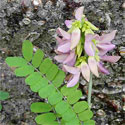 |
Adenodolichos
Fifteen species (tropical Africa), of which one Adenodolichos punctatus
is native to southern Africa (Zimbabwe). |
|
Aeschynomene
More than 150 species, native to tropical and subtropical regions, mainly in
Africa and South America. There are about 28 species native to southern
Africa, and a further three species that are cultivated in the region. |
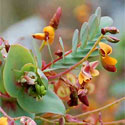 |
Alistilus
One species native to southern Africa - Alistilus bechuanicus. |
|
Alysicarpus
About 25-30 species, native from Africa to Asia, with
five species native to
southern Africa. |
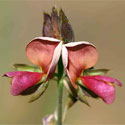 |
Amphithalea
About 70 species, native to Africa, and from southern Europe to
India. Forty-two species native to southern Africa. |
|
Antopetitia
One species, Antopetitia abyssinica, native to tropical Africa
(including Zimbabwe). |
|
Argyrolobium
About 70 species, native to Africa, and from southern Europe to
India. Forty-nine species native to southern Africa. |
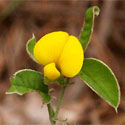 |
Aspalathus
The largest endemic genus of flowering plants in southern
Africa with a total of 279 species, mainly native to the Western Cape but extending as far north as
KwaZulu-Natal. Includes Aspalathus linearis (Rooibos tea). |
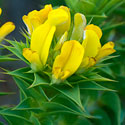 |
Astragalus
About 2000 species worldwide, especially diverse in the temperate regions of
Asia. Astragalus atropilosulus
is the only species native to southern Africa; in addition there is one
species naturalised and four
species that are cultivated in the region. |
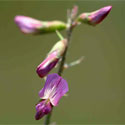 |
Baphia
About 80 species, native to Africa and Madagascar, with three species native to southern Africa. |
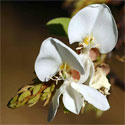 |
|
Bituminaria
Two species native in southern Africa. |
|
Bobgunnia One species native to southern Africa -
Bobgunnia madagascariensis. |
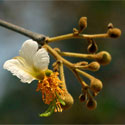 |
Bolusafra
One species: Bolusafra bituminosa, endemic to the Western Cape. See
revision: Moteetee, A. and van Wyk, B.-E. 2006. A revision of the genus
Bolusafra (tribe Phaseoleae, Fabaceae). South African Journal of
Botany 72(4): 604-608. |
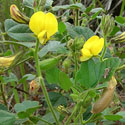 |
Bolusanthus
One species: Bolusanthus speciosus (Tree
wisteria), native to Limpopo, northern Mpumalanga and Swaziland. |
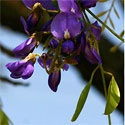 |
Bolusia
The 5-6 species are native to dry regions of Africa south of the equator,
with two species found in southern Africa (Namibia and Northern Cape). |
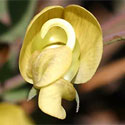 |
Calobota
Thirteen species native to southern Africa. Previously considered to be part
of Lebeckia. |
|
Calpurnia
About 16 species (Africa), with nine species native to southern
Africa. |
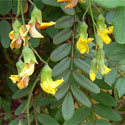 |
Canavalia
About 50 species,
found widely in warm regions, with six species native to southern Africa. |
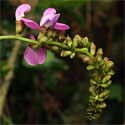 |
Cordyla
Five species, native to Africa and Madagascar, with one species,
Cordyla africana (Wild mango),
found in southern Africa. |
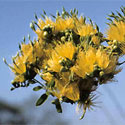 |
Craibia
Ten species, native to tropical Africa, with two species native to southern
Africa and one species cultivated in the region. |
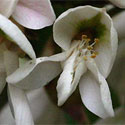 |
Crotalaria
About 600 species, native mainly to the tropics and subtropics, with
110 species native to southern Africa, four species naturalised, and
a further six species that are cultivated in
the region. |
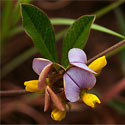 |
Cullen
About 40 species, with a distribution extending from Africa, through to
India, Burma, Philippines, Papua New Guinea and Australia. Three species are
native to southern Africa. |
|
Cyamopsis
About five species, distributed from Africa to India, with three species native to
southern Africa and one species naturalised in the region. |
|
Cyclopia
Twenty-three species, endemic to the Western and Eastern Cape. |
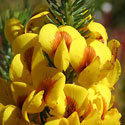 |
Dalbergia
About 159 species, native to warm regions, with 10 species native to southern
Africa and one that is naturalised in the region. |
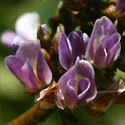 |
Dalbergiella
Three species, distributed in tropical Africa, of which one
Dalbergiella
nyasae is native to southern Africa (Zimbabwe and Mozambique). |
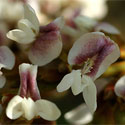 |
Decorsea
About four species, native to Africa and Madagascar, with three species found in
southern Africa. |
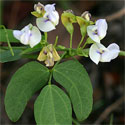 |
Derris
One species native to southern Africa: Derris trifoliata (recorded
from Mozambique). |
|
Desmodium
About 300 species, native to tropical and subtropical regions, with 15
species native to southern Africa and a further seven species that are
cultivated in the region. |
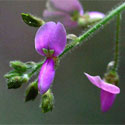 |
Dichilus
All five species are native to southern Africa. |
|
Dipogon
One species: Dipogon lignosus [= Dolichos lignosus, Dolichos
gibbosus], endemic to the Western and Eastern Cape. |
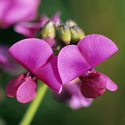 |
Dolichos
About 60 species, native from Africa through to east Asia, with 16
species found in southern Africa. |
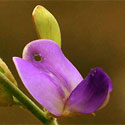 |
Dumasia
About eight species, found from Africa through to Asia, with one species,
Dumasia villosa, native to southern
Africa. |
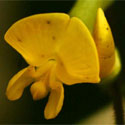 |
Eminia Four species
distributed in tropical Africa, of which two are native to southern Africa
(Zimbabwe and Mozambique). |
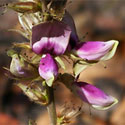 |
Eriosema About 130 species, occurring in tropical and
subtropical regions, with 46 species native to southern Africa. |
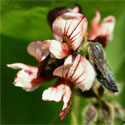 |
Erythrina
About 130 species, occurring in warm regions of the world, with
nine species native to
southern Africa, two species naturalised, and a further 10 species and two hybrids that are cultivated in the region. |
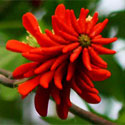 |
Flemingia
About 30 species, occurring in the Old World tropics, with one species,
Flemingia grahamiana, native to
southern Africa. |
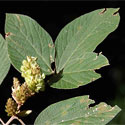 |
Galactia
About 50 species, found in the tropics and subtropics (mainly New World),
with two species native to southern Africa: Galactia tenuiflora
and Galactia striata (recorded from Zimbabwe and Mozambique). |
|
Hypocalyptus
Three species, endemic to the Western and Eastern Cape. |
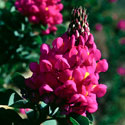 |
Indigastrum
About nine species, mainly south tropical Africa but one species occurring
throughout the tropics. Eight species native to southern Africa. |
|
Indigofera
About 730 species, occurring mainly in tropical and subtropical regions,
with 232 species native to southern Africa. |
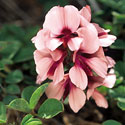 |
Kotschya
About 31 species, native to tropical Africa and Madagascar, with seven species
recorded from southern Africa. |
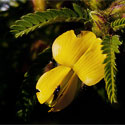 |
Lablab
One species: Lablab purpureus, which is widespread in Africa,
including in southern Africa. Subspecies uncinatus is considered
native to southern Africa whereas subspecies purpureus is considered
to be naturalised in the region. |
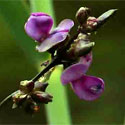 |
Lebeckia
Fourteen species, endemic to southern Africa with the main concentration of
species in the Cape. |
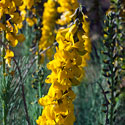 |
Lessertia
About 59 species, 56 of which are native to southern
Africa. |
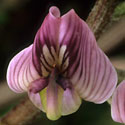 |
Liparia
About 20 species, endemic to the Western and Eastern Cape. |
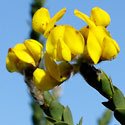 |
Lotononis
About 150 species, mainly African, extending to the Mediterranean and to
Pakistan. Almost all the species (142) are native to southern Africa. |
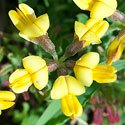 |
Lotus
About 100 species, widespread, with four species native to
southern Africa, two species naturalised, and an additional 11 species that are
cultivated in the region. This genus is not to be confused with the common name lotus
which applies to species of aquatic plants in the genus Nelumbo (family: Nelumbonaceae). |
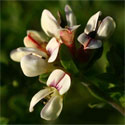 |
Macrotyloma
About 24 species (Africa and Asia), with 10 species
native to
southern Africa. |
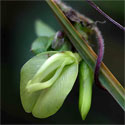 |
Melolobium
Fifteen species, endemic to southern Africa. |
|
Microcharis
About 35 species, native to Africa, Madagascar and the Arabian Peninsula,
with four species in southern Africa. |
|
Millettia
About 100 species, found in tropical and subtropical regions, with
four species native to southern Africa and a further seven species
that are cultivated in the region. |
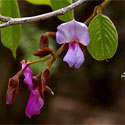 |
Mucuna
About 100 species, widespread in warm regions, with
five species native to
southern Africa and a further three species that are cultivated in the
region. |
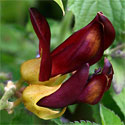 |
Mundulea
About 15 species, all endemic to Madagascar, except
Mundulea sericea
(= Mundulea suberosa), which is native to southern Africa. |
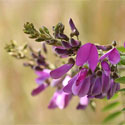 |
Neonotonia
One species: Neonotonia wightii (= Glycine wightii),
distributed in Africa through to Asia, including in southern Africa. |
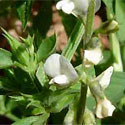 |
Neorautanenia
Three species, all native to southern Africa. |
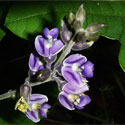 |
Ophrestia
About 13 species (Africa and Asia), with two species,
Ophrestia
oblongifolia and Ophrestia unifoliolata (recorded from
Zimbabwe), native to southern Africa. |
|
Ormocarpum
About 20 species (Old World tropics), with three species
native to
southern Africa. |
 |
Otholobium
Forty five species native
to southern Africa. |
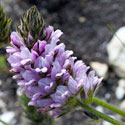 |
Otoptera
Two species, native to Africa, with one of them,
Otoptera burchellii
(=
Vigna burchellii), native to southern Africa. |
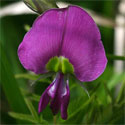 |
Pearsonia
About 13 species, 12 of which are native to southern Africa. |
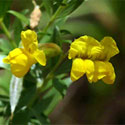 |
Pericopsis
Four species distributed in tropical Africa, of which one
Pericopsis
angolensis is native to southern Africa (Zimbabwe). |
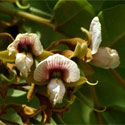 |
Philenoptera
Five species native to southern Africa. |
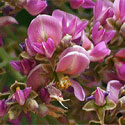 |
Podalyria
Twenty-five species, endemic to southern Africa, ranging from the
Western Cape through to KwaZulu-Natal. |
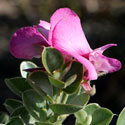 |
Polhillia
Six species, all endemic to the Western Cape. |
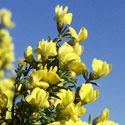 |
Pseudarthria About six species, occurring from southern Africa to Asia, Madagascar,
Mauritius and Réunion, with one species,
Pseudarthria hookeri, native to
southern Africa. |
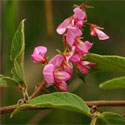 |
Pseudaminia Four species worldwide, all occurring in
tropical Africa, of which one Pseudominia comosa is native to
southern Africa (Zimbabwe). |
|
Psophocarpus
About 10 species worldwide in the Old World tropics, of which two,
Psophocarpus
scandens and
Psophocarpus lancifolius is native to southern Africa (Zimbabwe). |
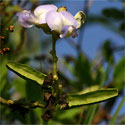 |
Psoralea
Thirty-six species, endemic to southern Africa, mainly in fynbos. |
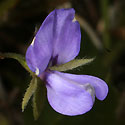 |
Pterocarpus
About 20 species, found in tropical regions, with four species native
to southern Africa and a further two species that are cultivated in the
region. |
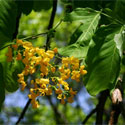 |
Ptycholobium
All three species are native to southern Africa. |
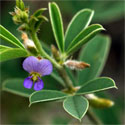 |
Rafnia
Nineteen species, endemic to southern Africa, occurring from the Western
Cape through to KwaZulu-Natal. |
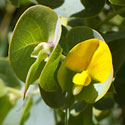 |
Requienia
About three species, all African, with two of them native to southern Africa. |
|
Rhynchosia
About 200 species, found throughout the tropics
and subtropics, with 79 species native to southern Africa and a
further species that is cultivated in the region. |
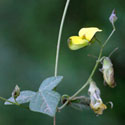 |
Rothia
Two species, native from Africa to India and Australia, with one of them,
Rothia hirsuta, occurring in southern Africa. |
|
Sesbania
Fifty-two species, native to warm regions and
usually growing in wet places. Eighteen species native to southern Africa,
three are naturalised and a further two are cultivated in the
region. Sesbania punicea (Red sesbania,
Rooi sesbania) is a
declared Category 1 invasive plant
in South Africa. |
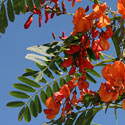 |
Smithia
About 30 species (Old World tropics), with one species,
Smithia erubescens, native to southern Africa. |
|
Sophora
About 60-70 species (warm regions worldwide), with three species native to
southern Africa, and an additional four species that are cultivated in the
region. |
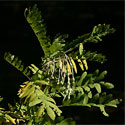 |
Sphenostylis
The seven or eight species are native to Africa and India, with five species found in
southern Africa. |
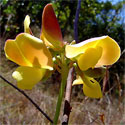 |
Stirtonanthus
Three species, endemic to the Western Cape. |
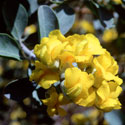 |
Stylosanthes
About 25 species, native to tropical and subtropical regions, with one
species, Stylosanthes fruticosa,
occurring in southern Africa, and a further three species from Central and
South America that are cultivated in the region. |
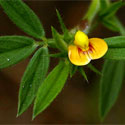 |
Sutherlandia
The five species are all native to southern Africa. |
 |
Swartzia
About 127 species, mainly occurring in tropical America but with two species
in Africa. Swartzia madagascariensis
is the only species native to southern Africa. |
|
Tephrosia
Over 400 species, native to warm regions, with 67 species
native to southern
Africa. |
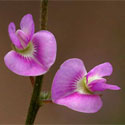 |
Teramnus
About eight species, widely distributed in warm
regions, with three species native to southern Africa. |
|
|
Trifolium (clovers)
About 250 species, widely distributed in temperate and
subtropical regions, with five species native to
southern Africa, 15 species that are naturalised, and a further 15 species that
are cultivated in the region. |
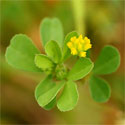 |
Trigonella
About 130 species, native to the Mediterranean region, central Europe,
Africa, Asia and Australia. One species is native to southern Africa, two
species are naturalised, and a further three species are cultivated in the
region. |
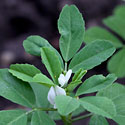 |
Uraria
Twenty species worldwide (Old World tropics), of which one
Uraria picta
is native to Zimbabwe. |
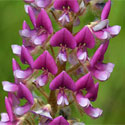 |
Vigna About
160 species, widespread in tropical regions, with 20 species native
to southern Africa, one species is naturalised, and a further three
species are cultivated in the region. |
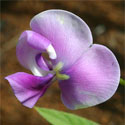 |
Virgilia
Two species, endemic to the Western and Eastern Cape. |
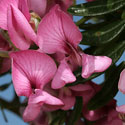 |
Wajira
One species recorded in southern Africa, native to Zimbabwe - Wajira
grahamiana [= Vigna macroryncha]. |
|
Wiborgia
Nine species, endemic to the Northern and Western Cape. |
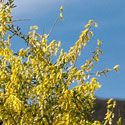 |
Wiborgiella
Nine species native to southern Africa. |
|
Xanthocercis
The two species are native to Africa and Madagascar, with one species,
Xanthocercis zambesiaca (= Pseudocadia zambesiaca),
native to southern Africa. |
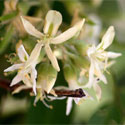 |
Xeroderris
One species: Xeroderris stuhlmannii
(= Ostryoderris stuhlmannii), native to savanna regions of
tropical Africa, including in southern Africa. |
 |
Xiphotheca
About nine species, endemic to fynbos of the southern Cape region. |
|
Zornia About 80 species, mainly native to Brazil. Five
species are native to southern Africa. |
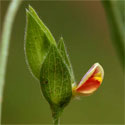 |
Genera naturalised in southern Africa
List from Germishuizen (2000).
Alhagi
The native distribution of the three species extends from the Mediterranean
region to Nepal. Alhagi maurorum has become
naturalised in localised dry areas of the Northern and Western Cape and is a
Category 1 declared invader plant
in South Africa. |
|
Arachis
About 22 species, native to South America.
Arachis hypogaea (Peanut or Groundnut) (see
Flora of Zimbabwe) is cultivated
in southern Africa and also occurs in natural vegetation as an escape.
In addition, Arachis repens (Amendoim rasteiro), which is native to
Brazil, is cultivated in southern Africa.
|
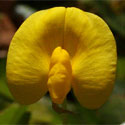 |
Cajanus
Two species, of which the one, Pigeonpea
Cajanus cajan,
is cultivated widely in the tropics, and has become naturalised in the
northerly parts of southern Africa. \ |
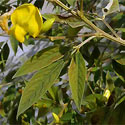 |
Clitoria
About 70 species, native to the tropics, mainly the neotropics.
Clitoria
ternatea has become naturalised in southern Africa and there are a
further two species that are cultivated in the region. |
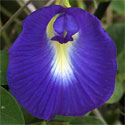 |
Cytisus About
30-35 species (Europe, North Africa and southwestern Asia), with one species
naturalised in southern Africa (Common broom -
Cytisus scoparius), and a further eight species and
one hybrid that are cultivated in the region. |
|
Genista About 87 species (Europe, Canary Islands, Mediterranean to
western Asia); one species is naturalised in southern Africa and an additional
nine species are cultivated in the region. |
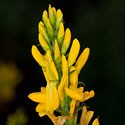 |
Glycyrrhiza (liquorice genus)
About 20 species, most of them in Eurasia, but also distributed across to
Australia, and in North America and temperate South America.
Glycyrrhiza
glabra (Liquorice) has become naturalised in the Western and Eastern Cape.
In addition, Glycyrrhiza echinata (native from eastern Mediterranean
to southwestern Asia) is cultivated in southern Africa. |
|
Lespedeza
About 30 species (eastern North America, easter and southern Asia and
Australasia), with one species naturalised in southern Africa, and a further
three species that are cultivated in the region. |
|
Lupinus (lupins)
About 200 species, native to the Americas, and Mediterranean Europe through
to the highlands of East Africa. Five species naturalised in southern Africa
and a further nine species are cultivated in the region. |
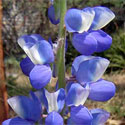
|
Macroptilium
Two species are cultivated in southern Africa, one of which,
Macroptilium atropurpureum occurs as a naturalised species in Harare, Zimbabwe. |
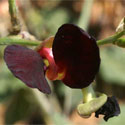 |
Medicago (lucerne genus)
About 50 species, native to Europe, Africa and Asia. No indigenous species
in southern Africa but five species and one hybrid are naturalised, and an
additional seven species are cultivated in the region.
Medicago sativa (Alfalfa, Lucerne, Medic)
is an important forage crop.
|
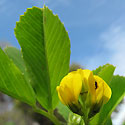 |
Melilotus
About 20 species, native to Europe, Asia and North Africa. There are three
naturalised species in southern Africa, and an additional four species that
are cultivated in the region. |
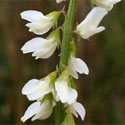 |
Ornithopus About six species, native to Europe,
Mediterranean region, western Asia, Atlantic Islands and South America.
Ornithopus sativus is a naturalised
species in the Western Cape, and there are an additional two species of
Ornthopus that are cultivated in southern Africa. |
|
Pueraria
About 20 species, native to Asia. One species,
Pueraria lobata (Kudzu vine,
Japanese arrowroot, Kudzuranker), has become naturalised in Mpumalanga and is a
declared Category 1 invasive plant
in South Africa. |
|
Robinia
About 20 species (or only 4 according to some authorities), native to
America and Europe. Robinia pseudoacacia
(Black
locust, Witakasia) has become naturalised in southern Africa and is a
declared Category 2 invasive plant
in South Africa. In addition, Robinia hispida (Rose acacia, Kelsey
locust) is cultivated in the region. |
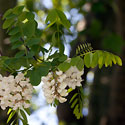 |
Spartium
One species: Spartium junceum (Spanish broom,
Spaanse besem), native to the Mediterranean region and
southwest Europe and now naturalised in southern Africa. It is a
declared Category 1 invasive plant
in South Africa. |
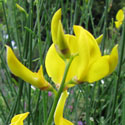 |
Ulex
Ulex europaeus (European gorse,
Gaspeldoring) has been introduced to southern Africa and has
become naturalised in forest areas of the Drakensberg in KwaZulu-Natal and
the Eastern Cape. It is a declared
Category 1 invasive plant in South Africa. In addition, Ulex minor
(Dwarf gorse), which is native to western Europe, is cultivated in the
region. |
|
Vicia (Broad bean genus)
About 140 species, native to Europe, Asia and North Africa, with six species
naturalised in southern Africa and a further 11 species that are cultivated
in the region, including Vicia faba
(Broad bean). |
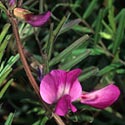 \ \ |
Other genera, cultivated in southern Africa
List from Glen (2002). The species name is provided in
genera that have only one species represented in southern Africa.
Adenocarpus complicatus Native to the
Mediterranean. |
|
Adesmia
Species details absent in Glen (2002). |
|
Amorpha fruticosa (Bastard indigo)
Native from eastern Canada to Mexico. |
|
Anagyris foetida (Bois puant) Native to the
Mediterranean. |
|
Anthyllis Three species cultivated. |
|
Baptisia australis Native to eastern USA. |
|
Barklya syringifolia Native to northeast
Australia. |
|
Biserrula pelecinus
Native from Greece to Portugal. |
|
Butea
Two species cultivated: Butea monosperma (Dhak, Flame-of-the-forest)
(native from Pakistan to Indochina), and Butea superba (Lata palasha,
Climbing palas) (native to Burma and Thailand). |
|
Cadia purpurea (Gadi, Hezaus, Salalma) Native from Kenya to Arabia. |
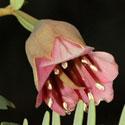 |
Calia secundiflora (Texas mescalbean)
[= Sophora secundiflora]
Native from Spain to Italy. |
|
Calicotome spinosa
Native from Spain to Italy. |
|
Caragana About 80 species
(Asia, eastern Europe); three species are cultivated in southern Africa. |
|
Carmichaelia Two species cultivated: Carmichaelia
aligera and Carmichaelia australis, both native to New Zealand.
|
|
Castanospermum australe (Australian Chestnut, Moreton Bay Chestnut)
Native to eastern Australia. |
|
Centrolobium robustum (Zebrawood)
Native to Brazil. |
|
Centrosema Two species cultivated: Centrosema
plumieri (native to South America), and
Centrosema pubescens
(native to Brazil). |
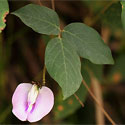 |
Chamaespartium sagittale
Native to Europe. |
|
Chorizema Two species cultivated: Chorizema
cordatum and Chorizema varium, both native to western Australia. |
|
Cicer Two species cultivated:
Cicer arietinum (Chickpea) and
Cicer trinitatis (native from Trinidad to Brazil). |
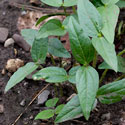 |
Cladrastis kentukea (American yellowwood) Native to
southern and central USA. |
|
Clianthus formosus (Desert pea, Sturt's desert pea)
Native to Australia. |
|
Colutea
Two species cultivated: Colutea arborescens (Bladder senna) (native
to Europe), and Colutea melanocalyx, native to Turkey. |
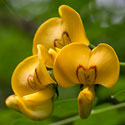 |
Coronilla
About 20 species (Atlantic islands, Mediterranean, Europe); six species
cultivated in southern Africa. |
|
Dalea Unidentified species listed in Glen (2002). |
|
|
Dendrolobium umbellatum
[= Desmodium umbellatum]
Has a wide distribution that includes tropical Africa,
Asia, Australasia, Indian Ocean islands and Pacific islands.
See
Encyclopedia
of Life. |
|
Dorycnium
Two species cultivated: Dorycnium herbaceum (native from France to
Armenia) and Dorycnium pentaphyllum (native to the Mediterranean). |
|
Galega officinalis (Goat's rue)
Native from Europe to Pakistan. |
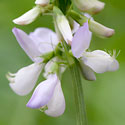 |
Gliricidia sepium (Madriado, Cacahuananche)
Native from Mexico to Guyana. |
|
Glycine max (Soya bean)
Domesticated in northeastern China from the wild Glycine soja, the
earliest evidence of cultivation dating to 3000 years ago. |
|
Goniogyna hirta
Native from Pakistan to Sri Lanka. |
|
Hardenbergia
Two species cultivated: Hardenbergia comptoniana (Wild sarsaparilla)
and Hardenbergia violacea (False sarsaparilla), both native to
Australia. |
|
Hedysarum coronarium (French honeysuckle)
Native to Europe. |
|
Hippocrepis About 21
species (Europe, western Asia, Mediterranean); three species are cultivated
in southern Africa. |
|
Hymenocarpus circinnatus
Native from Spain to Israel. |
|
Kennedia Sixteen species,
native to Australia; three species are cultivated in southern Africa. |
|
Laburnum Two species,
native to the mountainous regions of central and southern Europe, from
France to the Balkan Peninsula. Both species are cultivated in southern
Africa. |
|
Lathyrus (sweet peas and vetchlings)
About 160 species (temperate regions of Europe, North America, Asia and
tropical East Africa); 17 species have been cultivated in southern Africa. |
 |
Lens culinaris (Lentil)
Originates from the Near East and central Asia. People were harvesting
wild lentils by 11200 years ago and by 8800 years ago they were being
cultivated. |
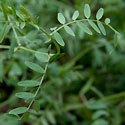 |
Maackia amurensis Native from Siberia to Taiwan. |
|
Myroxylon Two species cultivated: Myroxylon
balsamum (Balsam of Tolu) (native from Mexico to Colombia), and
Myroxylon peruiferum (native from Ecuador to Brazil). |
|
Onobrychis viciifolia (Sainfoin) Native to
central and western Europe. |
|
Ononis (restharrows) About
75 species (Mediterranean, Canary Islands, Ethiopia and Iran); five species
have been cultivated in southern Africa. |
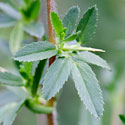 |
Pachyrhizus erosus (Yam bean)
Native to Mexico. |
|
Parochetus communis (Shamrock pea)
Native from mountains of tropical Africa through to southeast Asia. |
|
Phaseolus About 50 species, native to the Americas; nine species are
cultivated in southern Africa including
Phaseolus vulgaris, which includes most of the well-known edible bean
varieties. |
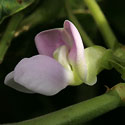 |
Piscidia
Two species cultivated: Piscidia carthagenensis (Barbasco,
Fish-poison tree) (native from Florida to Honduras), and Piscidia
piscipula (Jamaica dogwood, Fish-fuddle tree) (native from Mexico to
Ecuador). |
|
Pisum sativum (Garden pea)
Originates from the Near East, was being eaten by people at least 9500
years ago, and by 8500 years ago there is evidence of pea cultivation. |
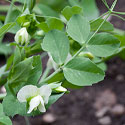 |
Platymiscium pinnatum Native from central
America to Brazil. |
|
Platypodium elegans Native to Brazil. |
|
Scorpiurus Two species cultivated: Scorpiurus
subvillosus (native from Portugal to Iran) and Scorpiurus
vermiculatus (native from the western Mediterranean to Madeira). |
|
Securigera securidaca Native from Spain to
Azerbaijan. |
|
Stongylodon macrobotrys (Jade vine) Native to
the Philippines. |
|
Styphnolobium japonica (Japanese pagoda tree)
[= Sophora japonica] Native to China and Korea. |
|
Swainsonia Two species
cultivated in southern Africa, both native to Australia. |
|
Sweetia fruticosa (Sucupira) Native from Brazil
to Bolivia. |
|
Teline
Three species cultivated in southern Africa, all native to the Canary
Islands and one also distributed in the western Mediterranean. |
|
Templetonia retusa (Coral bush) Native to
Australia. |
|
Thermopsis Two species cultivated: Thermopsis
fabacea and Thermopsis montana, both native to the western USA. |
|
Tipuana tipu (Tipu tree)
Native to Bolivia and Argentina. A
declared Category 3 invader plant
in South Africa. |
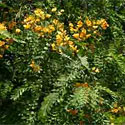 |
Wisteria About 10 species
(eastern USA, China, Korea and Japan); three species cultivated in southern
Africa. |
|
Publications
-
Germishuizen, G. 2000. Fabaceae. In: Seed Plants of
Southern Africa (ed. O.A. Leistner). Strelitzia 10: 262-303.
National Botanical Institute, Pretoria.
-
Glen, H.F. 2002. Cultivated Plants of
Southern Africa. Jacana, Johannesburg.
|
